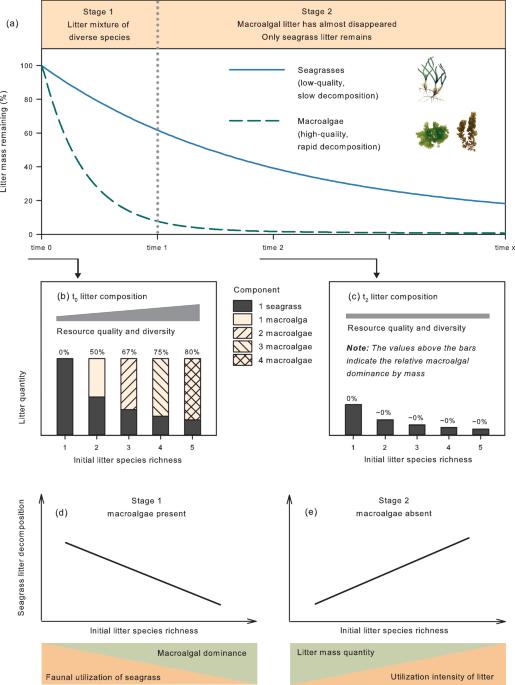Macrophyte litter mixtures mediate decomposition processes in coastal sediments
IF 8.1
1区 地球科学
Q1 ENVIRONMENTAL SCIENCES
引用次数: 0
Abstract
Understanding litter decomposition processes in coastal macrophyte habitats is critically important for predicting ecosystem functioning. However, decomposition processes of litter mixtures in coastal habitats remain largely unexplored. Here, we evaluated the litter mixture effects on the decomposition of six marine macrophytes (two seagrasses and four macroalgae) through in situ litter-mixing experiments with five levels of litter species richness and 36 different litter compositions. We found that the litter species identity and composition, rather than species richness, were crucial in structuring benthic faunal communities. Macroalgal litter, particularly Sargassum sp., hosted higher numbers of polychaetes and crustaceans than seagrass litter. More macroalgal presence induced faster decomposition rates of seagrass litter in the late stage, but not in the early stage. These findings suggest that changes in macrophyte diversity and composition can alter decomposition processes and, consequently, the sediment organic carbon stock through the transition of litter sources and benthic faunas. Presence of macroalgal litter triggers changes in benthic faunal communities and seagrass litter decomposition processes, resulting in alterations of the long-term sediment organic carbon stock, according to in-situ litter-mixing experiments with marine macrophytes.

营养繁殖植物废弃物混合物介导沿海沉积物的分解过程
了解沿岸大型藻类生境中垃圾的分解过程对预测生态系统的功能至关重要。然而,沿岸栖息地垃圾混合物的分解过程在很大程度上仍未得到研究。在这里,我们通过原位垃圾混合实验,评估了垃圾混合物对六种海洋大型植物(两种海草和四种大型藻类)分解的影响,实验采用了五种垃圾物种丰富度和 36 种不同的垃圾成分。我们发现,底栖动物群落结构的关键在于枯落物的物种特征和组成,而不是物种丰富度。与海草枯落物相比,巨藻枯落物,尤其是马尾藻枯落物,栖息着更多的多毛类和甲壳类动物。大型藻类越多,海草枯落物在晚期的分解速度越快,而在早期则不然。这些发现表明,大型藻类多样性和组成的变化会改变分解过程,进而通过枯落物来源和底栖动物群落的变化改变沉积物有机碳储量。根据海洋大型底栖生物的原位垃圾混合实验,大型藻类垃圾的存在会引发底栖动物群落和海草垃圾分解过程的变化,从而导致长期沉积物有机碳储量的改变。
本文章由计算机程序翻译,如有差异,请以英文原文为准。
求助全文
约1分钟内获得全文
求助全文
来源期刊

Communications Earth & Environment
Earth and Planetary Sciences-General Earth and Planetary Sciences
CiteScore
8.60
自引率
2.50%
发文量
269
审稿时长
26 weeks
期刊介绍:
Communications Earth & Environment is an open access journal from Nature Portfolio publishing high-quality research, reviews and commentary in all areas of the Earth, environmental and planetary sciences. Research papers published by the journal represent significant advances that bring new insight to a specialized area in Earth science, planetary science or environmental science.
Communications Earth & Environment has a 2-year impact factor of 7.9 (2022 Journal Citation Reports®). Articles published in the journal in 2022 were downloaded 1,412,858 times. Median time from submission to the first editorial decision is 8 days.
 求助内容:
求助内容: 应助结果提醒方式:
应助结果提醒方式:


